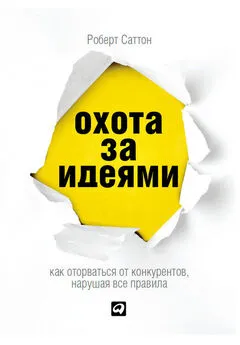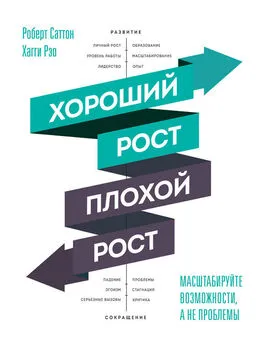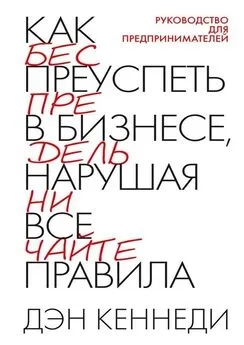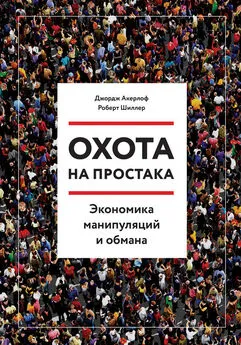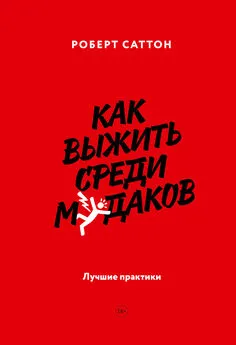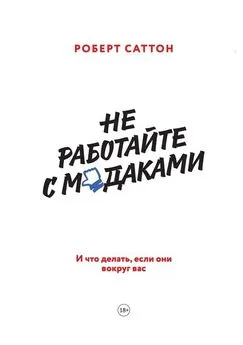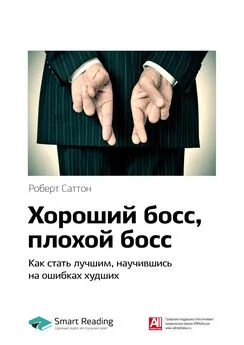Роберт Саттон - Охота за идеями. Как оторваться от конкурентов, нарушая все правила
- Название:Охота за идеями. Как оторваться от конкурентов, нарушая все правила
- Автор:
- Жанр:
- Издательство:Альпина Паблишер
- Год:2013
- Город:Москва
- ISBN:978-5-9614-3127-8
- Рейтинг:
- Избранное:Добавить в избранное
-
Отзывы:
-
Ваша оценка:
Роберт Саттон - Охота за идеями. Как оторваться от конкурентов, нарушая все правила краткое содержание
Охота за идеями. Как оторваться от конкурентов, нарушая все правила - читать онлайн бесплатно ознакомительный отрывок
Интервал:
Закладка:
251
Из речи Уильяма Э. Койна в корпоративном университете Motorola в г. Шаумбург, штат Иллинойс, 11 июля 2000 г.
252
Asakura, R. Revolutionaries at Sony (New York: McGraw-Hill, 2000), 42.
253
Zajonc, R. “Social Facilitation,” Science 149 (July 1965): 269–74.
254
Mullen, B., C. Johnson, and E. Salas. “Productivity Loss in Brainstorming Groups: A Meta-analytic Integration,” Basic and Applied Psychology 12 (1991): 2–23. См., например, McLaughlin, J. B., and D. Reisman. “The Shady Side of Sunshine,” Teachers College Record 87 (1986): 472–94; Sutton, R. I., and D. C. Galunic. “Consequences of Public Scrutiny for Leaders and Their Organizations,” in Research in Organizational Behavior, vol. 18, ed. (Greenwich, CT: JAI Press, 1996): 201–50 .
255
Kidder, T. The Soul of a New Machine (New York: Avon Books, 1981).
256
Nonaka, I. “Toward Middle-Up-Down Management: Accelerating Information Creation,” Sloan Management Review ( spring 1988): 9–18.
257
Kawasaki, G. The Macintosh Way (New York: Harper Collins, 1989), 16.
258
Rhodes, R. The Making of the Atomic Bomb (New York: Simon & Schuster. 1987; and Gleick, J., Genius: The Life and Science of Richard Feynman (New York: Pantheon, 1992), 160.
259
Hill, R. C. “When the Going Gets Tough: A Baldrige Award Winner on the Line,” Academy of Management Executive 7 (1993): 75–79.
260
Hill, R. C., “When the Going Gets Tough: A Baldrige Award Winner on the Line,” Academy of Management Executive 7 (1993): 79.
261
McCracken, G. Plenitude: Culture by Commotion (Toronto: Periph.Fluide, 1997).
262
McCracken, G. Plenitude: Culture by Commotion (Toronto: Periph.Fluide, 1997): 69.
263
Wetlaufer, S. Common Sense and Conflict: An Interview with Disney’s Michael Eisner. Harvard Business Review ( January-February 2000): 119.
264
Metcalfe, B., “Invention Is a Flower, Innovation Is a Weed,” MIT Technology Review ( November/December 1999): 54–57.
265
Там же, с. 57.
266
Balu, R. Listen (No, Listen Carefully). Fast Company ( May 2000): 307.
267
@Issue Magazine , vol. 6, no. 2. Fall, 2000: 16–23.
268
Druckerman, P. “How to Project Power Around the World,” Wall Street Journal , November 13, 2000, A23, A26.
269
Amabile, T. M. “Unleashing Creativity,” presentation at the Strategos Institute Revolutionaries’ Conference, San Jose, California, June 13, 2000.
270
Amablie, T. M. “How to Kill Creativity,” Harvard Business Review ( September-October 1998): 77–87.
271
Thuraisingham C., and C. O’Reilly, Homestead.com, teaching case, Palo Alto, CA: Graduate School of Business, Stanford University, 2000.
272
Из речи Тома Кугла перед участниками учебно-практического семинара Mayfield Fellows в Стэнфордском университете 30 июля 2000 г., Вудсайд, штат Калифорния.
273
Herrigel, E. Zen in the Art of Archery (New York: Random House, 1981).
274
Schrage, M. “What’s That Bad Odor at the Innovation Skunk Works?” Fortune , December 6, 1999.
275
Mintzberg, H. “The Manager’s Job: Folklore and Fact,” Harvard Business Review ( 1990) July – August: 49–61.
276
Gleick. Genius, 382.
277
Lazarus, R. S. “The Costs and Benefits of Denial,” in Stress and Coping: An Anthology, ed. A. Monat and R. S. Lazarus. (New York: Columbia University Press, 1985), 154–73.
278
Из личной беседы Герберта Саймона с Марком Фишманом 12 декабря 2000 г. Эта же мысль высказана в книге Г. Саймона: Simon, H. “Information Can Be Managed,” Think 33 (3), (1967): 8–12.
279
Kidder, T. The Soul of a New Machine, 60.
280
Schrage, M. Serious Play (Boston: Harvard Business School Press, 1999), 88.
281
Hertsgaard, M. On Bended Knee: The Press and the Reagan Presidency (New York: Schocken Books, 1989).
282
Galunic, C. D. “The Evolution of Intracorporate Domains: Divisional Charter Losses in High Technology, Multidivisional Corporations,” (Ph.D. diss. Palo Alto, CA: Stanford University, School of Engineering, 1994).
283
Eisenberg, E. M. “Ambiguity as a Strategy in Organizational Communication,” Communication Monographs 51 (1984): 227–42.
284
Reid, R. Architects of the Web: 1,000 Days that Built the Future of Business (New York: Wiley, 1997), 125.
285
Polanyi, M. “The Potential of Adsorption: Authority in Science has Its Uses and Its Dangers,” Science 141 (1963): 1012.
286
Watson, J. L. “China’s Big Mac Attack,” Foreign Affairs , May-June 2000.
287
Tilin, A. “Supreme O,” Wired , December 19, 1999, 178.
288
Gleick, J. Genius: The Life and Science of Richard Feynman (New York: Pantheon, 1992), 324.
289
Gleick, J. Genius: The Life and Science of Richard Feynman (New York: Pantheon, 1992), 387.
290
Goodall J. In the Shadow of Man (New York: Houghton Mifflin, 1988), 6.
291
Dyson J. Against the Odds (London: Orion Business Books, 1997), 264–65.
292
AsakuraR. Revolutionaries at Sony (New York: McGraw-Hill, 2000), 229.
293
Gundling E. The 3M Way to Innovation: Balancing People and Profit (New York: Kodansha, 2000).
294
Koppell T. Powering the Future (New York: Wiley, 1999), 15.
295
Salter C. Life in the Fast Lane // Fast Company ( October 1998): 78.
296
Millard A. Edison and the Business of Innovation (Baltimore: Johns Hopkins University Press, 1990), 9.
297
Anton T. Bold Science (New York: Freeman, 2000), 12.
298
Grove A. Only the Paranoid Survive (New York: Doubleday, 1996), 89.
299
Coutu D. L. “Creating the Most Frightening Company on Earth: An Interview with Andy Law of St. Luke’s,” Harvard Business Review ( September-October 2000): 146.
300
«Комитет 99» был образован в 1984 г. из руководителей и рабочих 55 предприятий General Motors и представителей 41 ячейки профсоюза рабочих машиностроительных отраслей для изучения и применения лучших подходов к интеграции людей и технологий в конкурентное производство небольшого автомобиля в США. – Прим. пер.
301
Langer E. J. “Minding Matters: The Consequences of Mindlessness-Mindfulness,” in Advances in Experimental Social Psychology, ed. L. Berkowitz (New York: Academic Press, 1989), 137–73.
302
Asakura R. Revolutionaries at Sony (New York: McGraw-Hill, 2000), 17.
303
March J. G. “Three Lectures on Efficiency and Adaptiveness in Organizations,” Swedish School of Economics, Helsinki, Finland, 1994, 53.
304
Кристенсен К. Дилемма инноватора: Как из-за новых технологий погибают сильные компании. – М.: Альпина Паблишер, 2012.
305
Tushman, M. L., P. C. Andersen, and C. O’Reilly III “Technology Cycles, Innovation Streams, and Ambidextrous Organizations: Organizational Renewal Through Innovation Streams and Strategic Change,” in Managing Strategic Innovation and Change, ed. M. L. Tushman and P. C. Andersen (New York: Oxford University Press, 1996).
306
United Automobile, Aerospace and Agricultural Implement Workers of America, сокр. UAW – Объединенный профсоюз рабочих автомобильной и авиакосмической промышленности и сельскохозяйственного машиностроения США. – Прим. пер.
307
Pfeffer, J., and R. I. Sutton. The Knowing-Doing Gap: How Smart Companies Turn Knowledge into Action (Boston: Harvard Business School Press, 2000).
308
Интервью с Гэри Хаем, директором подразделения совершенствования человеческих ресурсов, компания People Systems, Saturn Corporation, Детройт, Мичиган, 25 марта 1998 г.
309
Burrows P. and P. Elstrom. HP’s Carly Fiorina: The Boss // Business Week , August 2, 1999.
310
Hamel G. Leading the Revolution (Boston: Harvard Business School Press, 2000).
311
Alinsky S. Rules for Radicals (New York: Vintage Books, 1989).
312
Hamel G. Waking Up IBM // Harvard Business Review ( July – August 2000): 5–11.
313
Там же, с. 9.
314
Данный материал позаимствован из интервью с Аннет Кайл от 17 сентября 1998 г. Более подробное описание революции Кайл см. Pfeffer and Sutton. The Knowing-Doing Gap.
315
MacFarquhar L. The Gilder Effect // The New Yorker , May 29, 2000, 103–111.
316
LaBarre P. The Company Without Limits // Fast Company ( September 1999): 160–70.
317
Human Resources at the AES Corporation: The Case of the Missing Department. Case #SHR-3 (Palo Alto, CA: Graduate School of Business, Stanford University, 1997); а также O’Reilly III, C. A., and J. Pfeffer, Hidden Value (Boston: Harvard Business School Press, 2000).
318
Human Resources at AES, 15.
319
Katz R. The Effects of Group Longevity on Project Communication and Performance // Administrative Science Quarterly 27 (1982): 81–104; Katz R. and T. J. Allen. Investigating the Not-Invented-Here Syndrome: A Look at Performance, Tenure, and Communication Patterns of 50 R&D Project Groups // R&D Management 12 (1982): 7–19.
Читать дальшеИнтервал:
Закладка:
